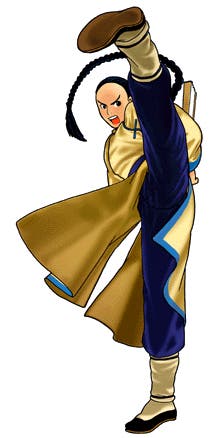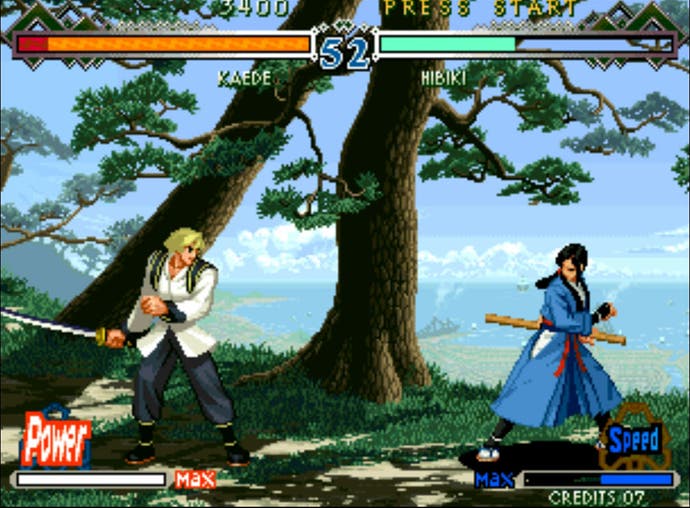The Last Blade 2 is SNK at its bawdy best
Cutting edge.
Maybe it's something in the water, or maybe it's because most of its residents would rather gulp back a beer to hydrate themselves, but there's something awfully fighty about Osaka. A bawdy counterpoint to the dignity traditionally associated with the city of Kyoto, it's no wonder that while Nintendo was pursuing delicate refinement in its craft through the 90s, further south things were a little scrappier. Think of the fighting game in its absolute pomp and you think of Capcom and SNK, two companies once locked in both fierce rivalry and jolly camaraderie, sparring then embracing one another like two friends tipping over themselves through the course of a booze-soaked evening.
Capcom's 90s output you'll know, of course, from Street Fighter, Darkstalkers, Marvel Super Heroes and more, while SNK's work of the era is likely just as familiar: evocative greats such as Fatal Fury, The King of Fighters, Samurai Shodown among others. Yet while Capcom has intermittently carried on fighting its corner with some relative success, SNK's star has waned, its output slowing to almost naught in recent years.

More's the pity, as I've always had a soft spot for SNK. Maybe it's something to do with how exotic these games once seemed: almost every 12-year-old had a SNES with Street Fighter, yet it was only the chosen few who had borne witness to a Neo Geo, let alone had the means to carry home one of its adorably oversized AES cartridges. These were the game boxes always carried out of reach in local game stores, behind the counter and perched high on a shelf, complete with glorious artwork and eye-watering price tag.
To a child in the 90s, SNK was synonymous with a certain type of luxury, a counterpoint provided by the Rabelaisian brilliance of its games: they were champagne to be gulped thirstily down until the room started to dizzily spin. As an adult with the means to acquire what was always out of touch in my youth, I wasted little time picking up a Neo Geo (I opted for the MVS unit originally intended for the arcade, where the cartridges are identical in all but name to their AES counterparts but are much, much cheaper - and with the change you can pick up a decent candy cabinet to house them all to boot).
Getting reacquainted with SNK's 90s best has been a delight in recent years - Metal Slug 3, for me, remains the peak of 2D scrollers, while Windjammers is simply the peak of two player video games full stop - but there's one game I keep returning to again and again. The Last Blade 2 isn't SNK's most famous game. It's hardly it's most revered, either. But for me, it's most definitely SNK's most magical: a fighter with grace, style and a little dash of 100 proof madness to bring it all home.
The Last Blade 2 remains so special because there's never been anything quite like it since. There was before, of course - as you might have guessed from its name, there was a predecessor a mere year before The Last Blade 2's 1998 release, itself a spiritual successor to SNK's popular Samurai Shodown series - but its streamlined, weapon-fuelled 2D combat remains unique. And it feels brilliant.
I'm afraid this isn't the place where you'll find in-depth analysis of The Last Blade 2's combat - I'm simply not good enough at fighting games to talk with any authority - or a rundown of the game's complete roster. For the past few years I've just been happy getting together with a friend and running through the same old rivalry: Lee vs Keiichiro Washizuka, the soft leather slippers and coiled-up poise of the martial arts master pitted against the sharp sword of the samurai.
Through that match-up you'll get a fairly good idea of what it is that makes The Last Blade 2 a great. In Lee you've got quick feet that burst into flaming arcs, an aerial attack with the overstated finesse of a wuxia hero and fists that are only ever fleetingly called into action. I love Lee's stance, his hands almost always clasped behind his back while he lets his feet do the talking. I love the flurry of his attacks, always coming at the end of an extended spell of patience. Grace and fury, all bundled together in one glorious whole.

Then there's Washizuka, happy to sit back and absorb attacks while waiting for his window. When it comes; step back, breathe in then move forward with one fierce slice, lopping off a sizeable chunk of an enemy's health bar. Use The Last Blade 2's repel system - a parry similar to Street Fighter 4's focus that leads to a fairly generous stun state - to open up that window at will. Absorb and attack, all while acting brilliantly noble through it all.
Nobility is something The Last Blade 2 has in spades - even in the wilder reaches of its character roster with more outlandish picks such as the freakish Mukuro or demon summoning magic girl Akari - and it's also not short of style. SNK's 90s output was famous for its style - its backdrops were consistently works of lurid detail and exquisite craft - and The Last Blade 2 sees the company firing on all cylinders. Feudal fields at sundown; battle-torn harbours; timber houses ravaged by flames - pixels have rarely been gathered towards something so beautiful.
Coming later in the Neo Geo's lifecycle, there's a technical accomplishment to The Last Blade 2 - the scaling of Art of Fighting finds a more subdued, artful home in Last Blade with its gentle pans that take in all those glorious backdrops - but it lends it a more timeless air. Great 2D games like The Last Blade 2 never age, and stumbling upon it now is like unearthing a Golden Harvest classic. It's just as enjoyable now as it ever was.
Last week's re-release on PlayStation 4 and Vita makes it easier to play than before (though I'm not budging from my MVS because frankly I'm awful like that), hopefully ensuring The Last Blade 2 finds a new audience. As for SNK? Late in April it made the small, sizeable move of rebranding, ditching the Playmore suffix it's carried the past 13 years and now calling itself, quite simply, SNK. There's a fresh emphasis on games, and an all-new King of Fighters to look forward to later this summer. Amidst all that, SNK restored its old slogan: 'The Future Is Now'. Maybe it's as true now as it was back then, but there's certainly been no better time to rediscover the company's brilliant past.

